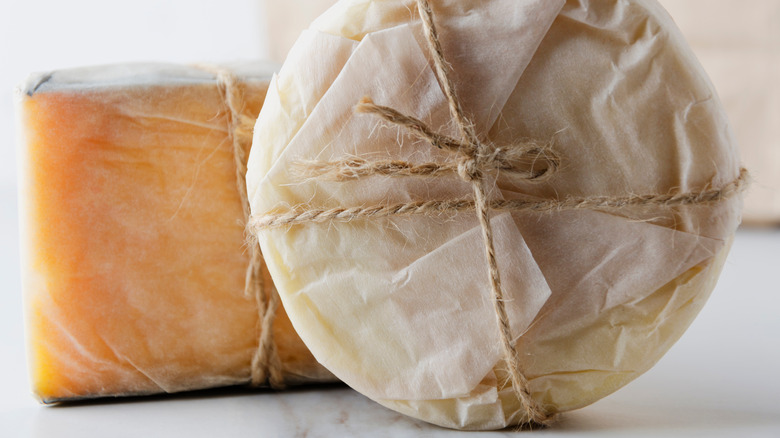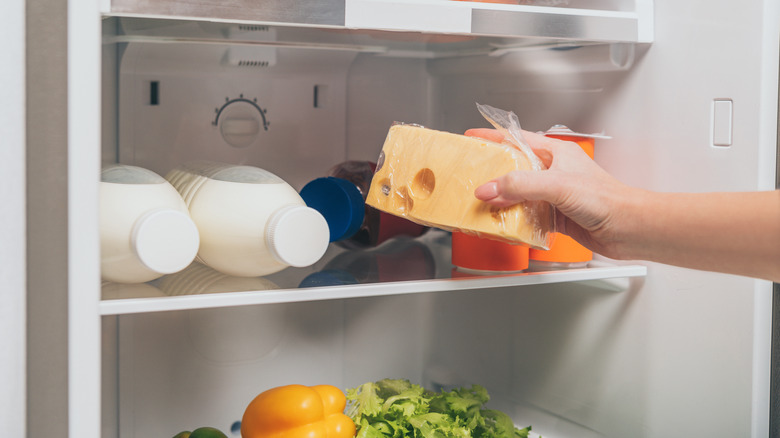The Best Way To Store Cheese If You Don't Have Cheese Paper
Proper cheese storage is key for maintaining its flavor and texture. Although most supermarkets sell cheese wrapped in plastic so consumers can see what they are purchasing, cheese is a living dairy food that needs to breathe, and plastic isn't the ideal long-term environment for it. Plastic wrap can transfer odors and an artificial taste to cheese, affecting its flavor, and can also suffocate it, killing necessary bacteria. It's advisable to wrap cheese in a material that allows air to pass through it, like cheese paper, to prolong its flavor and texture.
Cheesemongers and specialty markets that offer tastings will cut the cheese to your specifications and wrap it using a special cheese paper coated in wax, which allows air to circulate and absorbs moisture to prevent unwanted mold. Although plastic-wrapped cheese sold at quick turnaround markets should be fine temporarily, to maintain its integrity, consumers should rewrap it in wax, butcher, or parchment paper to mimic cheese paper if it isn't available.
How to properly wrap cheese
Turophiles (cheese lovers) can purchase cheese paper online if they eat a lot of cheese, but it's unnecessary. You can rewrap the cheese from the grocery store to create a microenvironment where its enzymes and bacteria can thrive. Then place the wrapped cheese in a plastic baggie or storage container to protect it from drying out and absorbing odors in the fridge. Don't forget to pierce the container with a few holes to allow the cheese to breathe.
You can also reuse cheese paper. Save the porous paper from the cheese you just finished, rinse it thoroughly, and allow it to dry before rewrapping a different cheese. Since it's paper, avoid soaking it, or it will fall apart.
Pungent blue cheeses, like Gorgonzola, Stilton, and Roquefort, should be double-wrapped to prevent their strong odors from permeating other foods. Avoid storing different varieties of cheese in the same container, especially if they are not in the same category (fresh, aged, soft white rind, semi-soft, hard, blue, and flavor added), so they don't pick up each other's tastes.
Where to store cheese
If your love of cheese doesn't extend to acquiring a cheese fridge or cellar like the "rabid cheese fans" competing in the Cheesemonger Invitational would, only purchase what you will consume within a few days. If the market doesn't offer tastings and you are unsure of the quality but still want to try it, buy the smallest amount available.
Cheese should be stored between 35 and 45 degrees in the refrigerator, so use the fruit or vegetable bin, which has a higher humidity and is warmer than the shelves. Hard cheeses like Parmigiano-Reggiano, however, can last at room temperature for extended periods.
Avoid freezing temperatures and the coldest areas in the fridge (bottom shelf and the back of the refrigerator) to preserve the cheese's flavor and texture. If you must freeze a surplus of cheese to prevent wasting it, allow it to thaw in the fridge before using it for cooking. The cheese's texture will change, becoming drier and crumbly, which is not ideal for something like mini charcuterie boards.
Cheese continues to ripen as it ages and should be discarded if it exhibits different characteristics, like strong ammonia or sour milk aromas. If cheese develops mold on the outside, it doesn't mean you have to throw it out. According to Mayo Clinic, it's recommended to remove at least 1 inch around and beneath the moldy section, after which the cheese should be deemed safe for consumption.



